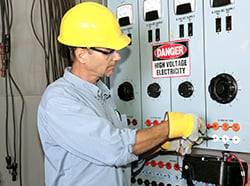 Each year, more than 300 deaths and 4,000 injuries in the workplace are caused by electrical hazards. From falls and burns to electric shock and even electrocution - contact with electrical energy is a serious danger to workers.
Each year, more than 300 deaths and 4,000 injuries in the workplace are caused by electrical hazards. From falls and burns to electric shock and even electrocution - contact with electrical energy is a serious danger to workers.
And unfortunately, for the past several years, the OSHA standards related to general electrical requirements and wiring methods have been some of the most frequently cited standards.
What can you do to meet these regulations and keep your workforce protected from the extreme dangers of electrical hazards?
Hazard Recognition
Electrical hazards are avoidable if your workforce is trained to recognize the conditions. Unfortunately many workers are unaware of the potential hazards present in their workplace. This lack of awareness makes them more vulnerable to electrical shock and electrocution. An abundance of resources are available to train your employees on the dangers of electrical hazards and how to better identify them.
Electrical Safety Tips
The majority of electrical accidents are caused by one of these factors:
- Usage equipment or installation,
- Unsafe work environment, or
- Unsafe work practices.
The use of insulation, guarding, grounding, electrical protective devices, and safe work practices can help prevent these incidents.
The Electrical Safety Foundation International (ESFI) outlines the following as tips for electrical safety in the workplace:
- Complete a detailed job plan and communicate it to all co-workers.
- Know safety requirements and follow them.
- Understand the construction and operation of the electrical equipment and the hazards involved.
- Identify all possible energy sources that could pose on-the-job hazards.
- Before working on or around electrical systems or equipment, identify the load circuits and disconnect. Remember, in some cases, turning power off may cause other hazards. Such hazards and additional guidance should be addressed in your work plan.
- Select the appropriate personal protective equipment (PPE). Remember, PPE must be worn until the electrical system is in a safe condition.
- Never assume that the equipment or system is de-energized. Remember to always test before you touch.
- Use lockout/tagout procedures.
- Make sure your test equipment is working properly both before and after you use it.
- If at any time the job becomes more hazardous than you had anticipated, stop and revise the plans
Construction Industry
There are specific OSHA standards related to electrical use in the construction industry. Along with these regulations, OSHA provides resources on the best practices for electrical safety and materials to help train your workforce on recognizing the hazards and best practices.
Updated OSHA Standard
It is important to also note a recent rule update regarding electrical safety, specially electric power generation, transmission, and distribution. Some revisions were made to both the construction and general industry requirements. This final rule became effective on July 10, 2014. Visit the OSHA page dedicated to the rule update for complete information.
Beyond OSHA
Aside from OSHA, the National Fire Protection Association (NFPA) also provides regulations related to electrical safety. The NFPA 70E is also known as the National Electrical Code (NEC). It is intended to be the “benchmark for safe electrical design, installation, and inspection to protect people and property from electrical hazards.” The standard is updated every 3 years, with the 2014 edition being the most recent version.
Additional Resources
- OSHA Safety and Health Topics – Electrical
- OSHA Training – Electrical
- OSHA Controlling Electrical Hazards Booklet
- NIOSH Workplace Safety & Health Topics – Electrical Safety
- ESFI Workplace Safety website





